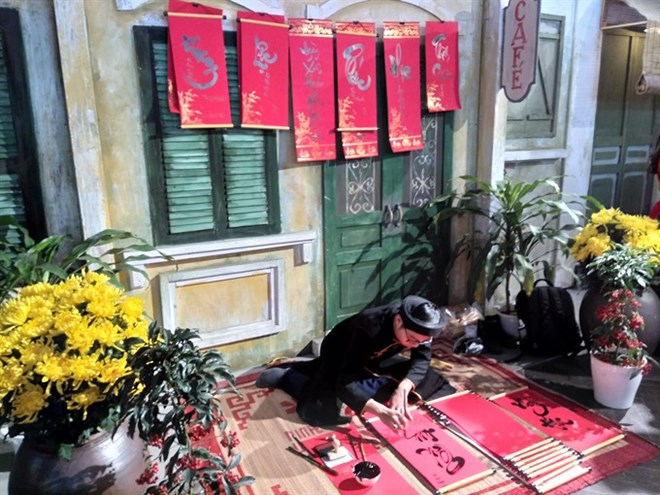



Steady hand:
A calligrapher displays his talent.(Source: VNA)
Children in Hanoi will enjoy an early celebration of the festival
through folk games, such as tugs of war and swings. Along with games, children
can try their hands at making banh chung (glutinous square cakes)
and li xi (lucky money envelope).
They will also learn to print and paint folk paintings and write calligraphy
once use as good luck decorations during Tet.
Together with the festival, an exhibition will be held until February 24
introducing visitors to a traditional Vietnamese Tet celebration and typical
worshipping space for the occasion 100 years ago. This will be done through a
display of wood carvings of French researcher Henri Oger and documents from
France’s Albert Kahn Museum.
Ancient painting genres from across the country, including Hang Trong and Kim
Hoang in downtown and on the outskirts of Hanoi, respectively, and Dong Ho in
the northern province of Bac Ninh, are also showcased.
Kim Hoang is a common name given to folk paintings printed on yellow and
red paper. It was invented in the second half of the 18th century and strongly
developed since the 19th century at Kim Hoang village in Van Canh commune
in Hanoi’s suburban district of Hoai Duc.
The subjects in Kim Hoang paintings are taken from the plain and
ordinary lives of the citizens of the Red River Delta, so they easily win
people’s hearts. Each painting has familiar sights of animals as well
as depicting daily life, Lunar New Year holidays and the worship of the
Kitchen Gods.
Hang Trong folk painting genre is traditionally produced on paper with one
carved woodblock inked in black to give an outline that is then filled in with
different colours by hand. Its artistic cousin, Dong Ho, is produced by a
series of woodblocks, each carrying a different colour.
Highlight of the programme is a ceremony setting
up cay neu (the New Year’s tree) on February 7, which is
one of the activities drawing visitors’ special attention, according to Nguyen
Thanh Quang, vice director of the Centre for Thang Long
Heritage Conversation.
"Vietnamese people have a custom of erecting a bamboo pole in front of their
house on the last day of the lunar year to expel evil, worship deities and pray
for good luck for the New Year,” he said. "People remove it on the seventh day
of the Lunar New Year to say farewell to their ancestors in heaven.”
New Year’s Eve this year will fall on February 16. From February 18 to 20,
various art performances will take place, including martial arts, water
puppetry, folk singing and dance.
Trinh Van Binh, 70, and his troupe from My Duc district on the outskirts of
Hanoi, will perform tứ linh (four sacred animals: dragon, kylin,
phoenix and tortoise) dance, one of the traditional dances of ancient Thang
Long, the former name of Hanoi.
"Our group of 25 people will perform dances and play music. We desire to uphold
the tradition of the homeland despite old age.”
Source: VNA